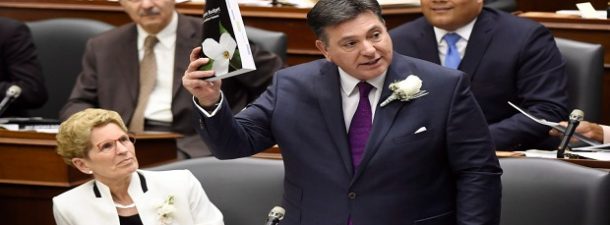Ontario’s finance minister delivered the province’s fiscal plan last Thursday. The government’s first “balanced budget” in a decade. “Balance budget” would mean Ontario will not run a deficit this year. The budget has taken care of almost all sections, and has addressed major concerns.
Finance Minister Charles Sousa is providing for seniors as well as youth. The program OHIP + has got the attention of both the supporters and the critics. The program OHIP +, is meant to provide universal drug coverage to children and youth regardless of family income. Under this new pharma care program more than 4,400 prescription drugs will be free for anyone under 25 starting next year. It will cover all drugs currently available under the Ontario Drug Benefit program, with no co-payment or deductible, and the program is expected to cost $465 million per fiscal year once it’s up and running. With this program Ontario is easing parent’s worries while making healthcare more affordable for them.
Ontario has been facing condemnation for having the fewest number of hospital beds of all the provinces and terrortries, a dismal 2.3 per 1000 available people. Even a smaller province Newfoundland and Labrador tops the list with 4.6. Ontario has shown its concern for the healthcare by budgeting $11.5 billion in new health-care spending over the next three years, an amount that’s $7 billion higher than the province had previously planned. Another $ 1.3 billion to help cut wait time to see specialist, and getting key services is another welcome step. Still, the problem of waiting time is gigantic and it would need more than just an allocation. It would call for a strategy that would end the woes of those who have to wait for long.
Various cities have been demanding increasing the funding for transit. Finance minister has made an attempt by making it cheaper for the Ontario seniors for getting around. Seniors will now be able to get a part of their transit expenses refunded under a new tax credit. The program will come into effect on July 1, and will cover 15 per cent of eligible transit costs, up to $130 per person annually. An attempt to address the core issue of Transit has been partially achieved by creating fund to issue a credit for seniors only.
Childcare too has got adequate attention of the Finance minister. Ontario has planned to create 24,000 new licensed child care spots, 60 per cent of which would be government-subsidized. That would come at a cost of $200 million. Finance Minister has created provision for building new schools in high growth areas and help the existing ones get a facelift. Whether, setting aside just about $ 16 billion in the next decade for new construction as well as renovations would be good enough? Finance Minister could have been little moderate. For students going for work experience, $190 million earmarked over three years to create 40,000 placements for them and for recent graduates, seem to have addressed the cause with rightful allocation. Education and justice for the indigenous communities has got adequate attention too. The government plans to spend $200 million over three years to boost postsecondary education and training opportunities for indigenous people. Meanwhile, $44.2 million will be spent in the next two years to expand or establish programs to make the justice system more culturally relevant, including the Gladue Program, which encourages courts to consider non-custodial sentences for indigenous offenders. Another $2 million will be spent in that same time frame to develop anti-racism programs that will be designed and delivered by indigenous people.
The provincial Liberals are increasing tobacco taxes and giving municipalities the power to levy a hotel tax. Tobacco tax rates will rise by $10 per carton of cigarettes over the next three years, starting with a $2 jump. But will deter the smokers or merely add to the revenue, needs to be seen. Southern Ontario’s booming housing market poured hundreds of millions more than expected into Ontario’s coffers last fiscal year and helped generate $637 million more than projected in land transfer tax revenue. The land transfer tax is expected to bring in $3.1 billion this fiscal year.
A balanced budget that has taken into consideration and allocated funds for key concerns should have found a due response from the opposition. However, their reactions have been as usual, that of full of criticism. Perhaps both the opposition parties have their eyes set on the debt only. Despite reaching balance in its latest budget, Ontario’s debt continues to grow — with projections putting it at $312 billion for 2017-2018. The province’s net debt is expected to rise to $336 billion in 2019-20. Interest on debt is the fourth largest spending area, at $11.6 billion.
Ontario’s NDP Leader Andrea Horwath, meanwhile, has said that the budget does nothing address the needs of cash-strapped families already struggling with hydro bills and housing costs. She and her party have a genuine concern. Progressive Conservative Leader Patrick Brown said that the fiscal plan is nothing but a ploy to win over voters ahead of next year’s provincial election. Well which ruling party hasn’t done so; keeping the voters in focus and presenting a budget that please them?







No Comments
Comments for Budget that provides balance are now closed.